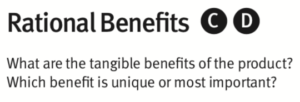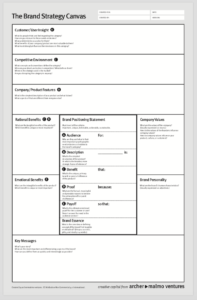I’m not a branding strategist. I am not a designer. I came into technical marketing through the backdoor of developer evangelism. In terms of my own approaches to marketing, I have reasonably good instincts but nothing resembling formal training. That said, I know when something is awful.
A few years ago, my friend and occasional colleague Patrick Woods – then of the advertising and PR agency Archer Malmo, now of CloudFlower – introduced me to their creation: The Brand Strategy Canvas. At first glance, it looked like a variation of the Lean Canvas or the Business Model Canvas. Since I don’t do branding, I noted it as “potentially useful” and moved on.
Fast forward a year and I joined a new company that had a great team, a grand Vision, the beginnings of a good product, and an awful name. We worked through the canvas line by line and block by block.. and came out with something tangibly better and clearer.
Intro to the Brand Strategy Canvas
This isn’t about writing a Mission Statement. I know 98% of those are crap and suspect another 1.8% of them are crap. This is more fundamental about knowing who your customer is, what your company is, and how the two come together. Given that, let’s walk through the five core areas.
First, we have to get into our target customer’s head. We have to understand who they are, what they value, how they think of the space (not us!), and what about us benefits them the most.
Do they all share a demographic? A geography? A common interest? A common title/role/responsibility? What is their biggest pain? How do they describe the problem? How big is the problem for them?
If you don’t have a target customer, stop. You don’t have a company, you have a project.
 Next, what does our product do or do uniquely? At this point, most tech people jump into the technology stack and how they deliver their product instead of what it actually does. If at all possible, stay away from jargons, acronyms, and complex terms.
Next, what does our product do or do uniquely? At this point, most tech people jump into the technology stack and how they deliver their product instead of what it actually does. If at all possible, stay away from jargons, acronyms, and complex terms.
For example, if we build an API that performs Machine Learning-backed Automatic Speech Recognition to get time series data of the words in an audio or video file, that’s a mouthful. Alternatively, we could describe the same thing as “we let you search audio and video so you can find who said what and when” tells much the same story that lightly or even non-technical people can understand.
 Next, what is happening in your market? We have to understand where our (first!) niche is, who else is in it, and how we can approach it uniquely or in a way that is better than our competition.
Next, what is happening in your market? We have to understand where our (first!) niche is, who else is in it, and how we can approach it uniquely or in a way that is better than our competition.
Too many people will search a couple times and call it complete. For this one, I prefer looking for similar concepts/companies that have collapsed. What made them close? How are you approaching the problem differently? Has the industry, customer, complementary goods/services, or underlying/available technology changed significantly?
Other people will suggest you completely ignore competitors. While I understand that mindset, understanding how they are/aren’t describing themselves and what their target customers are can be incredibly valuable. Don’t be afraid of competitors, but know where they are strong/weak.
 Next, what are the rational benefits? This one is pretty self-explanatory and can usually be measured. Does this save time, money, staffing or reduce risk? Then describe it: how big and how soon?
Next, what are the rational benefits? This one is pretty self-explanatory and can usually be measured. Does this save time, money, staffing or reduce risk? Then describe it: how big and how soon?
At this point, you may only have hypotheses or assertions but eventually you should replace these with actual numbers, testimonials, or a case study. That said, not all target customers will want all/any of those so choose the best for your market.
 Finally, what’s the emotional payoff? Saving money is great but if this makes me a better person or makes me feel better about myself, that’s a compelling hook to consider.
Finally, what’s the emotional payoff? Saving money is great but if this makes me a better person or makes me feel better about myself, that’s a compelling hook to consider.
For example, Tom’s built a brand on “one for one” where you buy a pair of shoes and they send a pair to someone in need. As a result, you’re not just buying a pair of shoes but the knowledge that you’ve helped someone else.
In your case, what’s the hook? Are you solving a societal issue? Are your employees technical marvels who people envy? Do your competitors mock kittens? Any little edge or improvement or excitement that you give customers is a benefit. Remember that.
By working through the Brand Strategy Canvas, you’ll have to stop and think about each of those aspects and how they fit together. Probably the single most important part is that your team will have to talk through these items and decide how to address them. Ironically, you’ve probably done the same on your technology stack numerous times.. a part which your customers will never see.
After working through the Canvas and helping others through it, I wish every company would spend a little more thought on how they approach their brand, market, and mindset.
If you’d like to learn more, check out Patrick’s book “The Brand Strategy Canvas” available on Amazon.



I am so much impressed to see this post which is clearly the main point of marketing. In addition would like to say If you want to achieve the set goals, you need a strategy – the marketing strategy. How do you want to achieve your goals, which market position do you take in the long term?
Interesting your point of view.
I’m a designer and a Marketing Professional.
I often wonder what brand is and how to do better management. I really appreciate your concept, but I believe it needs to be tested with research and review.
How can we work together to create a truly rich and innovative material?
Very helpful tips there, thumbs up!